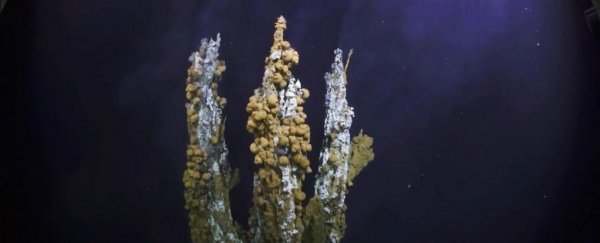While many people are using virtual reality (VR) software to create more engaging media content in the form of movies and games, a team of researchers is using it to explore a hydrothermal vent that lies roughly a mile (1.6 kilometres) under the sea.
Before now, the task of exploring these hydrothermal vents - which are incredibly dangerous because they continuously spew boiling clouds of toxic elements into the surrounding waters - would have fallen on the shoulders of remotely controlled vehicles (ROVs).
While these underwater drone-like contraptions are great, they only offer a small, windowed view that makes it incredibly hard to perform studies.
So when researchers from the Helmholtz Centre for Ocean Research in Kiel, Germany decided to study the hydrothermal vents inside the Lau Basin - a dangerous, volcanic region of the ocean floor that lies on the fault line between the Australian and Pacific tectonic plates - they wanted something that would give them a more complete picture.
"Imagine walking through Manhattan and only being allowed to see [the city] through the viewfinder of a camera," chief scientist Tom Kwasnitschka, from the Helmholtz Centre said of the ROVs to Maya Wei-Haas from Smithsonian Magazine. "What kind of experience would you get?"
To solve this, the team decided to turn to the world of VR. The hope is to create a virtual rendition of the actual seafloor that researchers can explore at their own pace without the threat of danger or all the annoyances that come along with submersible devices.
Plus, with a fully completed map, they can take their studies back to the lab instead of spending so much time at the actual vents.
But this task is much easier said than done, because to create the virtual world, they first had to capture images of the real area. To pull this off, the team set out on board the Schmidt Ocean Institute's research vessel Falkor (named after that creepy dragon dog from The Never Ending Story).
While on Falkor, the team used a highly advanced ROV called the Remotely Operated Platform for Ocean Sciences (ROPOS), a submersible device that weighs around 3.5 tonnes and is capable of recording video in outstanding 4K quality, even when faced with the darkness of the Lau Basin.
 NOAA
NOAA
According to Haas, the team spent three days imaging an area about the size of 74 football fields. These images were then turned into a 3D map of the seafloor that has such a high resolution that the researchers can distinguish individual blades of sea grass, which is remarkable compared to the underwater photography of yore (remember the intro to Titanic?).
"It's a very compelling experience to see a black smoker field and feel your way around," Kwasnitschka told Smithsonian Magazine about the experience. "Suddenly you don't bump [the ROV] into things anymore because you can turn your head and see that spire you are about to knock into."
Not only did the map offer a new, easier-to-navigate view of the vents, it also enabled the team to pinpoint specific areas to take samples from. Before now, finding good samples has been a challenge, because of the limited visibility that comes with ROVs.
"You [usually] haste from corner to corner trying not to miss the exciting things. But you can't see very far and you don't know where you are," says Kwasnitschka.. "You simply don't know where the good rocks are."
The team hopes that their new VR method will help other oceanic researchers explore more of the world's oceans, even if they still have to use ROVs to actually capture the images. After all, water covers more than 70 percent of Earth, and less than 5 percent has been explored.
Other than exploring the oceans, VR is seeing use in other areas of research, too. Earlier this year, psychologists found evidence that VR therapies might aid people suffering from paranoia or bipolar disorder. NASA is also experimenting with VR to hopefully allow users on Earth to one day explore the Martian landscape.
Needless to say, VR is more than just the future of entertainment. It'll be awesome to see how researchers implement it in the future.
Check out the video below to see a 360 degree view of the vent made by the team:
